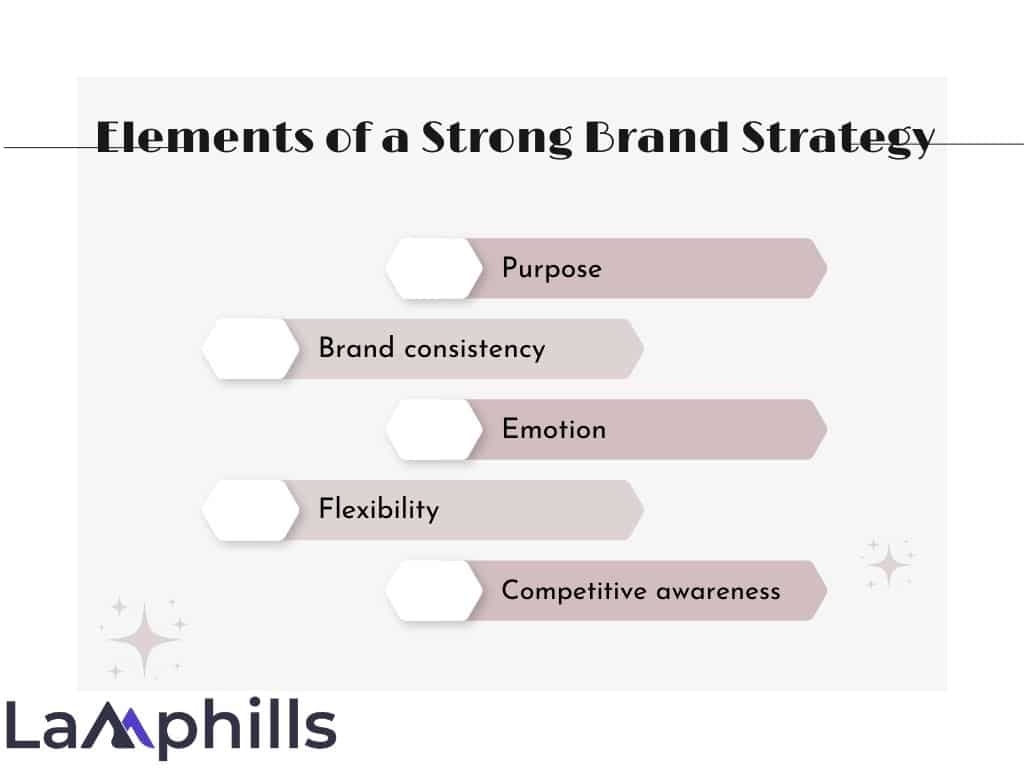In any business, branding, and strategy work hand in hand and they can’t be intertwined. And they both worked together to birth what is either known as “branding strategy” or “brand strategy”. Without the effect of this concept, your business will be void and bland.
In effect to avoid that and set yourself apart from your competition and in turn, build customer loyalty, then keep reading to find out what you need to do.
Key Points
- A brand is a concept in business that identifies its target audience, helps them find a specific company, product, or service, and distinguishes them from competitors.
- Branding is the process of using visual elements and other key elements to build a brand identity that is visible and appealing to consumers.
- A branding strategy is an action plan detailing how a business will present its brand to its target audience to build awareness, loyalty, and consistency.
- Key elements of a strong brand strategy include purpose, brand consistency, emotion, flexibility, and competitive awareness.
- Effective branding strategies include attitude branding, individual branding, product branding, co-branding, minimalist branding, and brand extension branding.
What is a Brand?
A brand is simply a concept in business that detects its target audience or consumers, helps them find a specific company, product, or service, and then distinguishes them from their competitors.
What is Branding?
Branding on the other hand is the process of using a brand’s visual elements and combining them with the brand’s tone, voice, color, and other key elements to build an identity that is visible and appealing to its consumers.
What is a Branding Strategy?
Before a building is structured and put into what it should be, an architect is needed in the scene to map out a building plan. Now a branding strategy in this case is the building plan while your business is the building. In this light, in order to get your business in good shape you will need to get hold of a branding strategy.
That being said, a branding strategy can be referred to as an action plan that has specific details on how a business or organization will present its brand and what it stands for to its target audience or consumers.
There are many benefits that come with having a branding strategy. Should I talk about the long-term connection with customers, the awareness, and loyalty it attracts, referrals, brand consistency it promotes, equality, and so on. It’s a lot to list.
Generally, the whole concept of a brand strategy is to remain relevant, to be seen by consumers, and to be patronized by those consumers over the competition. But then the biggest misconception you should eliminate as possible as you can is that your brand doesn’t solely revolve around your product, logo, website, and name. It takes more than that to evoke your customer’s emotions and meet their needs. Believe me when I say that your brand is a big deal.
Meanwhile, to remain relevant in an ever-evolving space where competitors are springing up at all angles, you should know it’s no child’s play. But don’t fret, that’s why I am here. Let’s quickly look at some of the essential components that can keep your business relevant for decades.
The Elements of a Strong Brand Strategy

These elements you are about to witness will help your brand be in check as you create your guidelines. It will serve as a foundation on which your brand strategy will stand, so move at my pace:
#1. Purpose
As a business owner, you should be able to detect what drives you, what carries you to work, why your brand exists, what your brand promises to your target audience, and why you wake up every day. If you are able to answer all these questions then you will understand what your brand’s purpose is.
Your purpose is what really differentiates you and your competitors. To even make the process easier, just define your brand’s customer, mission statement, and values and your brand purpose will become crystal clear and push you through challenges.
#2. Brand consistency
To be perfect in being consistent, just avoid talking about things that won’t enhance your brand, stick to things that will. Make sure that every angle and section of your business, both the ones intended for the audience or not, is in sync with your brand’s message. Believe me, you won’t keep up with two identities and you will end up confusing your audience so stick to one.
#3. Emotion
One thing that stirs up human beings is emotions, both negatively and positively. And if you can maneuver that factor and turn it to favor your brand, you will be the happiest human alive. Listen, customers are not always rational! Know that and know peace.
#4. Flexibility
Don’t be wired with a lot of rules, because you need to be flexible to remain relevant. It might be a little bit hard to be consistent and still remain flexible, I know, but let’s look at it from another angle. Consistency is probably on the angle to set a standard for your brand while flexibility is needed to make adjustments that can enhance interest and distinguish you from your competition. Flexibility eliminates limitations and promotes creativity.
#5. Competitive awareness
If you accept your competitors in good faith then you will make a lot of progress as a brand. Learn from your competition and use them to improve your own strategy. As long as their target audience is the same as yours, just watch what they do. Keep tabs on them and explore them until they see you as a competitor.
To help you effectively analyze your competitors and enhance your branding strategy, use this FREE Competitor Analysis Template.
Competitor Analysis Template.PDF
Top Branding Strategies to Employ in Your Brand
There are a lot of branding strategies and methods in existence today and we are going to explore a few you can use in your brand:
#1. Attitude Branding Strategy
Just as its name implies, it’s a form of branding that has to do with feeling or attitude that causes a customer to associate with your brand. Take Nike as an example, with the “Just Do It” slogan, they were able to promote and convince a lifestyle that customers can enjoy by wearing their product. If it could work for them, it can work for you too.
#2. Individual Branding Strategy
This method of branding is when a product or service develops a unique identity and a different brand name just so it can attract new customers in the market. A good example of this is Unilever, they use individual branding. They have three different divisions and each of them is one of the best-known brands.
#3. Product Branding Strategy
This is mostly used by companies hoping to create a recognizable brand and reach the company’s target audience using a specific product of theirs. To do this, they usually associate a logo, name, color, or design to that specific product. One of the brands that employed this branding strategy is Apple’s MacBook offerings. The “Air” “Pro” and “Mac”. You can see that these products convey the quality of the product offering.
#4. Co-Branding Strategy
The co-branding can also be seen in the same light as a brand partnership. It involves the unifying of different brands to join and become a fused brand. With their market, customer base, and values being combined together, they can easily become the best in the market. Another good example of the method of strategy is Nike and Micheal Jordan and how they came together to form something big for themselves.
#5. Minimalist Branding Strategy
This particular type of branding is one that uses minimalist symbols and then creates an image for themselves such as MasterCard. Take its logo for a more visual example, you might not know what the color signifies but at first glance, you’d know it belongs to MasterCard.
#6. Brand Extension Branding Strategy
This type of branding stands for when a brand uses another of its popular brands to establish and grow other brands or a new product on other brands. They have an extension and then want to use their already famous brand to build up that extension.
Having seen all these, let’s now move over to the most exciting version of this guide.
How to Build an Effective Branding Strategy that Works
Since the start of this journey, we have been on and about having an effective branding strategy and now let’s look at how you can successfully carry out this said strategy.
#1. Practise storytelling
I have mentioned in the guide how emotions can mean a lot to humans like us, well telling or having a story is still in sync with what can stir up an emotion and you can successfully carry out a branding strategy by having a compelling brand story.
The essence of having this brand is that it sparks a connection between your brand and your target audience. Also by sharing your backstory, how you started, what prompted you to start, and the challenges you went through while on the course, you can quickly stir up emotions and cause people to follow your business and get to know more about you on a deeper level.
#2. Find your brand voice
Brand voice is mainly one phrase or a particular pattern of words a brand uses to convey a message either across digital marketing channels, to a customer, or on its website. This has a sort of connection with your identity because it effortlessly tells people the type of brand messaging your business uses.
Because I don’t see this element often being used, it might interest you to know that a brand voice and tone can either make your target audience trust or doubt you. A brand voice helps with displaying or relaying a brand’s personality and its values. It also sets you in the mood and shows your audience what they should expect from you.
#3. Develop a brand identity design
A brand identity or design simply covers how your business appears visually to the public. The identity design that makes up your brand needs to be visible in every angle of your business, your products, websites, and marketing platforms. These brand identity designs come in the form of color palettes, fonts, or even photography styles.
The essence of a brand identity is mostly to tell your target audience what your brand is about in addition to your point of view and taste level, without even having to go for an in-depth search on what your brand does.
Imagine walking into a brand store and you see a body wash that comes with a ribbon and chic packaging, or a magazine that has a sweet color combination, you will be able to recognize that brand even without being in a close range. You might be further instigated to purchase that product, and there, the power of a great brand design. It can also be recognized with a fun shape or elements on a website.
Just anyone can see that, get an emotional response, and will either reach out for collaborations or to make a purchase, either way, you are earning from paying attention to your brand design.
In any case, where there is an absence of this brand design, your brand will have no visual identity nor will it have any target audience reaching out.
#4. Stick to your brand values
Once you have a clear value, your business will be known for it and eventually you can channel out energies, in the form of collaborations or partnerships, that are not in line with your value. Your value will also help build communities, brand positioning, and potential customers who are interested in what you offer.
So sit down and ask yourself, why your brand exists, what matters most to you, and what your business is constantly looking to solve. Once you answer these questions, then you can understand your brand’s values, beliefs, and principles around your business.
Most of these values can usually be found under your mission statements and from there, you can create a brand guideline for the smooth running of your company.
#5. Define your brand vibe
Lastly, your brand vibe is also an important factor when it comes to building an effective brand strategy. A brand vibe is a common sentiment that is seen usually on a brand’s website, social media channel, product packaging, and the like.
It doesn’t have to be serious, just something light, fun, playful, sarcastic and aesthetically pleasing. It should be able to easily attract feelings, either of interest or a pleasing feeling, just by merely looking at it.
Yours can give off that memorable and lasting impression that will evoke a reaction.
Conclusion
In summary, a successful brand strategy has a lot to do with connections and emotions easily sparked up by your brand’s value, brand voice, and a design that shows off your personality without much hassle.
If you have a strong brand strategy, you can easily build connections, relationships, and an army that stays, come rain come shine. It literally sets your business up for success. Have any questions, reach out to me in the comments.
Related Articles
- 15 Famous Brand Positioning Examples to Inspire Your Brand Strategy (+ Branding Tips)
- HOW TO MEASURE BRAND AWARENESS: Tips To Improve Your Brand Strategy
- What Is a Message Strategy and How to Build an Effective One for Your Brand
- Branded Content Marketing: The Powerful Strategy Big Brands Don’t Want You to Know






